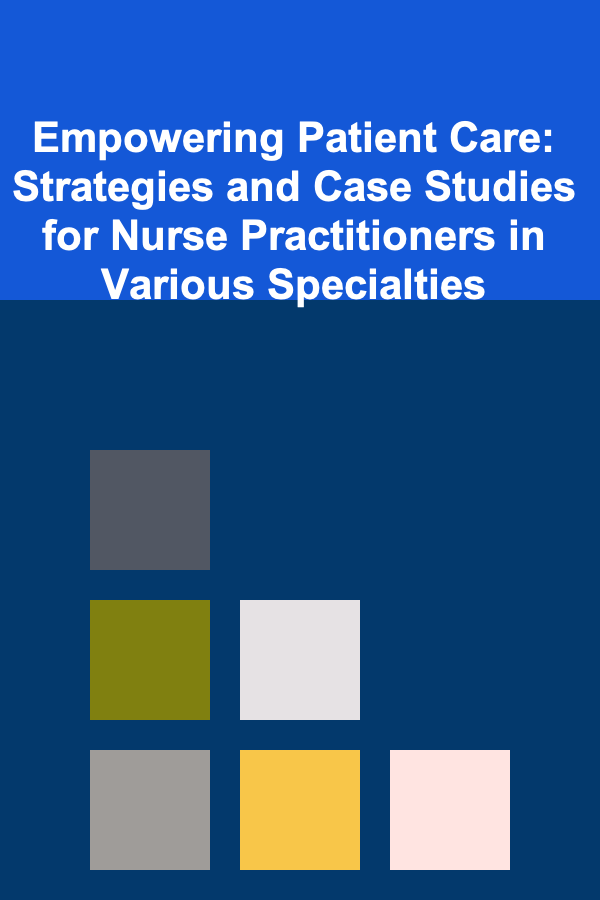
Empowering Patient Care: Strategies and Case Studies for Nurse Practitioners in Various Specialties
ebook include PDF & Audio bundle (Micro Guide)
$12.99$6.99
Limited Time Offer! Order within the next:

Nurse Practitioners (NPs) are integral to the healthcare system, bridging the gap between nursing and medicine. They are trained to assess, diagnose, treat, and manage a variety of patient conditions, and their role is becoming increasingly important as healthcare systems strive to provide more accessible and cost-effective care. In this article, we'll explore actionable strategies that Nurse Practitioners in various specialties can adopt to improve patient care. Along with these strategies, we'll look at real-life case studies to demonstrate their practical application in clinical settings.
The Importance of Nurse Practitioners in Modern Healthcare
Nurse Practitioners possess a unique skill set that allows them to address patient needs from a holistic perspective. By integrating advanced nursing knowledge with clinical expertise, they offer high-quality care that is both patient-centered and evidence-based. The role of NPs is especially critical in primary care, geriatrics, pediatrics, oncology, and other specialty areas, where they often serve as the primary healthcare providers, particularly in underserved or rural areas.
Given the rising demand for healthcare services and a shortage of physicians in some regions, the role of Nurse Practitioners is increasingly pivotal in enhancing the quality of patient care. In fact, studies have shown that NPs provide care that is comparable to that of physicians in many clinical settings, often with improved patient satisfaction.
Key Strategies for Empowering Patient Care
1. Embrace Evidence-Based Practice (EBP)
Evidence-Based Practice is the cornerstone of quality healthcare. By relying on the best available research, clinical expertise, and patient preferences, Nurse Practitioners can provide care that is both effective and personalized.
Actionable Steps:
- Stay Updated: Continuously review medical literature and clinical guidelines in your specialty. Subscribe to journals, attend conferences, and engage with professional organizations.
- Incorporate Best Practices: Use the latest evidence to inform clinical decisions. For example, when managing chronic diseases like diabetes, follow updated guidelines for medication management and lifestyle interventions.
- Patient-Centered Care: Tailor interventions to meet the specific needs and preferences of your patients, empowering them to actively participate in their care.
Case Study:
In a pediatric clinic, a nurse practitioner incorporated EBP by adopting new research on early screening for developmental delays. The decision led to earlier identification of autism spectrum disorders (ASD), which resulted in timely referrals to specialists and early intervention programs, significantly improving patient outcomes.
2. Enhance Communication Skills
Effective communication is a critical component of patient care. Nurse Practitioners must be able to listen actively, explain medical conditions and treatment options clearly, and build trust with patients. Strong communication also helps in team collaboration, particularly when working alongside physicians, specialists, and other healthcare professionals.
Actionable Steps:
- Active Listening: Pay attention to both verbal and non-verbal cues from patients to better understand their concerns and fears.
- Clear and Concise Explanations: Simplify complex medical terms and tailor your communication to the patient's level of understanding. Use visual aids if necessary.
- Empathy: Show compassion and understanding, acknowledging the emotional and psychological impact of health conditions on patients.
Case Study:
A nurse practitioner in a family practice clinic worked with an elderly patient who was resistant to taking prescribed medications. By taking the time to understand the patient's concerns and fears about side effects, the NP was able to explain the benefits and potential risks in a way that reassured the patient. This patient became more compliant with the prescribed treatment plan, leading to better management of their hypertension.
3. Foster Collaborative Teamwork
Collaboration with other healthcare professionals is essential for providing holistic care. Nurse Practitioners often work in interdisciplinary teams alongside physicians, social workers, pharmacists, and other specialists. Effective teamwork ensures that patients receive comprehensive care that addresses all aspects of their health.
Actionable Steps:
- Regular Team Meetings: Participate in or lead team meetings to discuss patient care plans, share knowledge, and review treatment protocols.
- Referral Networks: Build strong relationships with specialists to ensure smooth referrals when a patient requires care outside your scope of practice.
- Mutual Respect: Cultivate a culture of respect and shared decision-making within your team, where each member's expertise is valued.
Case Study:
In an oncology practice, a nurse practitioner regularly consulted with a multidisciplinary team that included oncologists, nutritionists, and mental health counselors. By working collaboratively, the team provided holistic care to cancer patients, addressing not only the physical effects of the disease but also mental health and nutritional needs. This approach led to improved quality of life for patients undergoing treatment.
4. Focus on Preventative Care and Health Promotion
Prevention is often the best treatment. Nurse Practitioners are in an ideal position to focus on preventative measures, such as regular screenings, lifestyle counseling, immunizations, and education on chronic disease management. By prioritizing prevention, NPs can help reduce the burden of chronic conditions, leading to healthier populations and lower healthcare costs.
Actionable Steps:
- Screening Programs: Offer routine screenings for common conditions like hypertension, diabetes, and cancer to detect issues early.
- Patient Education: Educate patients on the importance of healthy behaviors such as diet, exercise, smoking cessation, and stress management.
- Vaccination: Promote and administer vaccinations, especially in vulnerable populations such as children, the elderly, and immunocompromised patients.
Case Study:
In a family health clinic, a nurse practitioner initiated a smoking cessation program for patients. Through a combination of counseling, pharmacotherapy, and regular follow-up, the NP was able to help multiple patients quit smoking, significantly reducing their risk for chronic diseases such as heart disease and lung cancer.
5. Leverage Technology for Enhanced Patient Care
Technology is transforming healthcare by improving access, efficiency, and outcomes. Nurse Practitioners can utilize telemedicine, electronic health records (EHR), and patient management tools to enhance their practice. Technology also enables remote monitoring and better coordination of care across different healthcare providers.
Actionable Steps:
- Telemedicine: Incorporate virtual visits for patients who have difficulty coming to the office, such as those with mobility issues or in rural areas.
- EHR Utilization: Make the most of your electronic health record system to track patient progress, identify trends, and ensure accurate documentation.
- Remote Monitoring: Use wearable devices and health apps to monitor patients with chronic conditions like diabetes or heart disease.
Case Study:
A nurse practitioner in a cardiology clinic used telehealth to conduct follow-up visits for patients with chronic heart conditions. By utilizing remote monitoring tools and video consultations, the NP was able to closely track patients' blood pressure, weight, and other vital signs, making timely interventions that reduced hospital readmissions.
Conclusion
Empowering patient care is not just about providing medical treatments; it's about improving the overall patient experience through effective communication, collaborative care, prevention, and the use of evidence-based practices. For Nurse Practitioners, this requires a continuous commitment to learning, adapting to new technologies, and working collaboratively with patients and healthcare teams. By adopting these strategies, NPs can not only improve the quality of care they provide but also foster stronger, more trusting relationships with their patients, ultimately leading to better health outcomes.
In the face of a growing and diverse patient population, Nurse Practitioners have a unique opportunity to make a significant impact. By embracing these strategies and learning from real-world case studies, NPs can lead the way in transforming patient care for the better.
Reading More From Our Other Websites
- [Home Budget 101] How to Meal Plan on a Budget: A Step-by-Step Guide to Reducing Grocery Costs
- [Personal Finance Management 101] How to Manage Debt with a Debt Snowball or Debt Avalanche Method
- [Personal Financial Planning 101] How to Create a Comprehensive Tax Plan for Individuals: Deductions, Credits, and Strategies
- [Home Staging 101] How to Stage a Home That's Still Occupied by You
- [Home Storage Solution 101] How to Create Stylish Shoe Storage Ideas That Fit Your Decor
- [Home Maintenance 101] How to Extend the Life of Your Water Heater with Proper Maintenance
- [Home Family Activity 101] How to Set Up a Fun Family Quiz Night with Questions for All Ages
- [Home Cleaning 101] How to Tidy Up Your Home Before Guests Arrive
- [Home Space Saving 101] How to Conquer the Toy Tsunami: Creative Toy Storage Solutions for Every Room
- [Mindful Eating Tip 101] Best Approaches to Mindful Eating for People with Diabetes and Glycemic Concerns

How to Care for Your Induction Cooktop
Read More
How to Create a Checklist for Essential Paperwork
Read More
How to Find the Best Office Chair for Comfort and Support
Read More
How To Learn a Language Through Storytelling
Read More
How To Explore Sustainable Crypto Practices
Read More
How to Live a Virtuous Life: Exploring Aristotelian Ethics
Read MoreOther Products

How to Care for Your Induction Cooktop
Read More
How to Create a Checklist for Essential Paperwork
Read More
How to Find the Best Office Chair for Comfort and Support
Read More
How To Learn a Language Through Storytelling
Read More
How To Explore Sustainable Crypto Practices
Read More